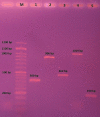Screening for Causative Mutations of Major Prolificacy Genes in Iranian Fat-Tailed Sheep
- PMID: 29334207
- PMCID: PMC5767932
- DOI: 10.22074/ijfs.2018.5247
Screening for Causative Mutations of Major Prolificacy Genes in Iranian Fat-Tailed Sheep
Abstract
Background: The presence of different missense mutations in sheep breeds have shown that the bone morphogenetic protein receptor 1B (BMPR1B), bone morphogenetic protein 15 (BMP15) and growth differentiation factor 9 (GDF9) genes play a vital role in ovulation rate and prolificacy in ewes. Therefore, the present study aims to investigate BMPR1B, BMP15 and GDF9 gene mutations in prolific ewes of Iranian fat-tailed Lori-Bakhtiari sheep.
Materials and methods: In the present experimental study, genomic DNA was extracted from whole blood of 10 prolific Lori-Bakhtiari ewes with at least two twinning records in the first four parities to identify point mutations of the BMPR1B, BMP15 and GDF9 genes, using DNA sequencing.
Results: The results obtained from DNA sequencing showed a new synonymous mutation (g.66496G>A) in exon 8 of the BMPR1B gene, without any amino acid change. Sequencing of the BMP15 gene revealed a deletion of 3 bp (g.656_658delTTC) in exon 1, leading to an amino acid deletion (p.Leu19del). Four single nucleotide polymorphisms (G1:g.2118G>A, G2:g.3451T>C, G3:g.3457A>G and G4:g.3701G>A), were detected in exons 1 and 2 of the GDF9 gene, two of which caused amino acid substitutions (G1: p.87Arg>His and G4: p.241Glu>Lys). These amino acid alterations are proposed to have a benign impact on structure and function of the GDF9 polypeptide sequence.
Conclusion: Three major prolificacy genes (BMPR1B, BMP15 and GDF9) were polymorphic in Lori-Bakhtiari sheep, although none of the major causative mutation was detected in this sheep type. Further studies using high throughput methods such as genome-wide association study (GWAS) and evaluation of other candidate genes are necessary in the future.
Keywords: BMP15; BMPR1B; Fertility; GDF9; RFamide-Related Peptide-3; Rats; Sheep.
Copyright© by Royan Institute. All rights reserved.
Conflict of interest statement
The authors declare no conflicts of interest.
Figures



Similar articles
-
Polymorphisms of the BMPR1B, BMP15 and GDF9 fecundity genes in four Chinese sheep breeds.Arch Anim Breed. 2024 Feb 7;67(1):51-60. doi: 10.5194/aab-67-51-2024. eCollection 2024. Arch Anim Breed. 2024. PMID: 40655877 Free PMC article.
-
Genome-wide association study to identify genomic regions affecting prolificacy in Lori-Bakhtiari sheep.Anim Genet. 2018 Oct;49(5):488-491. doi: 10.1111/age.12700. Epub 2018 Aug 5. Anim Genet. 2018. PMID: 30079564
-
Patterns of expression of messenger RNAs encoding GDF9, BMP15, TGFBR1, BMPR1B, and BMPR2 during follicular development and characterization of ovarian follicular populations in ewes carrying the Woodlands FecX2W mutation.Biol Reprod. 2007 Dec;77(6):990-8. doi: 10.1095/biolreprod.107.062752. Epub 2007 Aug 22. Biol Reprod. 2007. PMID: 17715428
-
Oocyte-expressed genes affecting ovulation rate.Mol Cell Endocrinol. 2005 Apr 29;234(1-2):57-66. doi: 10.1016/j.mce.2004.08.013. Mol Cell Endocrinol. 2005. PMID: 15836953 Review.
-
Fecundity genes in sheep.Anim Reprod Sci. 2004 Jul;82-83:247-53. doi: 10.1016/j.anireprosci.2004.04.001. Anim Reprod Sci. 2004. PMID: 15271457 Review.
Cited by
-
The expression and mutation of BMPR1B and its association with litter size in small-tail Han sheep (Ovis aries).Arch Anim Breed. 2021 May 28;64(1):211-221. doi: 10.5194/aab-64-211-2021. eCollection 2021. Arch Anim Breed. 2021. PMID: 34109270 Free PMC article.
-
The relationship between G1 (c.260 G>A) and G4 (c.721 G>A) polymorphisms in the GDF9 gene and the litter size of sheep: A meta-analysis study.J Adv Vet Anim Res. 2023 Dec 31;10(4):599-607. doi: 10.5455/javar.2023.j715. eCollection 2023 Dec. J Adv Vet Anim Res. 2023. PMID: 38370904 Free PMC article.
-
Polymorphism Detection of GDF9 Gene and Its Association with Litter Size in Luzhong Mutton Sheep (Ovis aries).Animals (Basel). 2021 Feb 22;11(2):571. doi: 10.3390/ani11020571. Animals (Basel). 2021. PMID: 33671790 Free PMC article.
-
Polymorphism of fecundity genes (BMP15 and GDF9) and their association with litter size in Bangladeshi prolific Black Bengal goat.Trop Anim Health Prod. 2021 Mar 26;53(2):230. doi: 10.1007/s11250-021-02679-2. Trop Anim Health Prod. 2021. PMID: 33772358
-
Genetic polymorphisms of fecundity genes in Watish Sudanese desert sheep.Vet World. 2019 Apr;13(4):614-621. doi: 10.14202/vetworld.2020.614-621. Epub 2020 Apr 5. Vet World. 2019. PMID: 32546903 Free PMC article.
References
-
- Abdoli R, Zamani P, Mirhoseini SZ, Ghavi Hossein-Zadeh N, Nadri S. A review on prolificacy genes in sheep. Reprod Domest Anim. 2016;51(5):631–637. - PubMed
-
- Foroughinia G, Fazileh A, Eghbalsaied S. Expression of genes involved in BMP and estrogen signaling and AMPK production can be important factors affecting total number of antral follicles in ewes. Theriogenology. 2017;91:36–43. - PubMed
LinkOut - more resources
Full Text Sources
